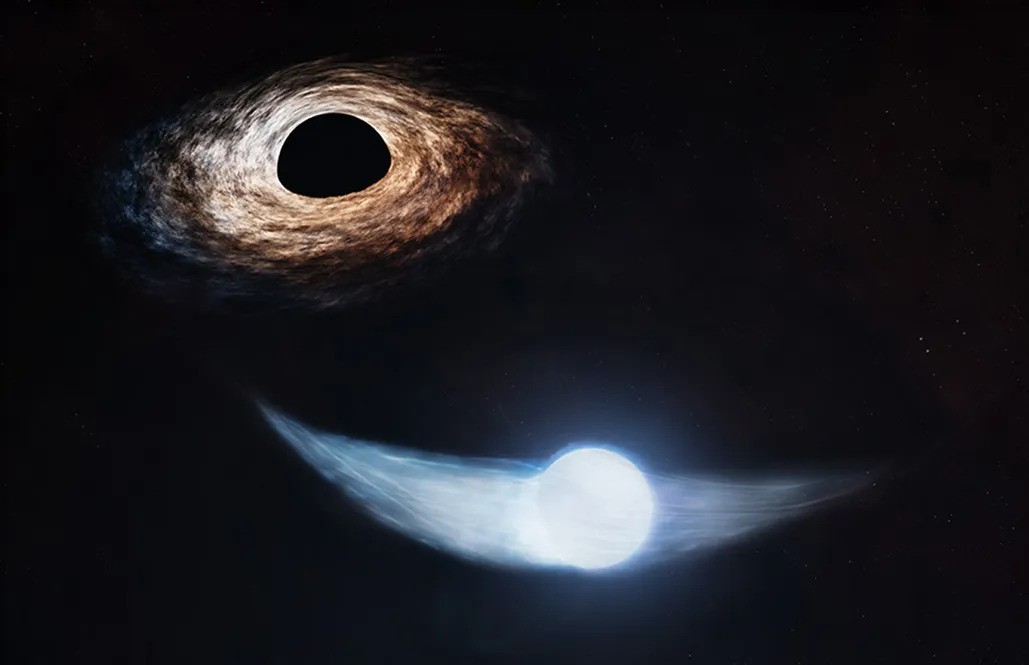Scientists used a number of space telescopes to observe tidal collapse events in stars. It turned out that some kind of black hole tears stars apart one by one.

Mysterious black hole and its surroundings
A massive black hole has torn apart one star and is now using that stellar debris to engulf another star or smaller black hole previously in its sights.
The discovery, made with NASA’s Chandra X-ray Observatory, Hubble Space Telescope, NICER (Neutron Star Interior Composition Explorer), Neil Gehrels Swift Observatory and other telescopes, is helping astronomers connect two mysteries where only hints existed before. The study is published in the journal Nature.
In 2019, astronomers observed a signal from a star that got too close to a black hole and was destroyed by its gravitational forces. The shredded remains of the star form a disk orbiting the black hole as a kind of stellar graveyard.
Objects approaching a black hole
However, after a few years, this disk expanded outward, and it is now directly in the path of another star, or perhaps a stellar-mass black hole orbiting a massive black hole at a safe distance. This orbiting star is now constantly, about once every 48 hours, passing through the debris disk as it spins in a circle. When this happens, the collision causes bursts of X-ray radiation, which astronomers have detected with Chandra.
Scientists have documented many cases where an object gets too close to a black hole and is torn apart by a single flash of light. Astronomers call such events “tidal disruption events”.
In recent years, astronomers have also discovered a new class of bright flashes from the centers of galaxies, which are detectable only in X-rays and repeat many times. These events are also associated with supermassive black holes, but astronomers couldn’t explain what caused the semi-regular bursts of X-rays. They called them “quasi-periodic eruptions”.
Intermittent flashes AT2019qiz
This tidal event, known as AT2019qiz, was first detected by the Palomar Observatory’s wide-field optical telescope, called the Zwicky Transient Facility, in 2019. In 2023, astronomers used Chandra and Hubble to study the debris left behind when the tidal wave ended.
Chandra’s data were obtained from three different observations, each separated by about 4-5 hours. The total Chandra exposure lasted about 14 hours and found only a weak signal in the first and last debris, but a very strong signal in the middle observation.
Astronomers used NICER from there to frequently observe AT2019qiz for repeated X-ray bursts. Data from this instrument showed that AT2019qiz lit up about every 48 hours. Observations with the Swift telescope and India’s AstroSat telescope solidified this conclusion.
Hubble’s ultraviolet data, taken at the same time as Chandra’s observations, allowed scientists to determine the size of the disk around the supermassive black hole. They found that the disk had gotten large enough that if some object orbited the black hole with a period of about a week or less, it would collide with the disk and cause an eruption.
“This is a big breakthrough in our understanding of the origin of these regular eruptions,” said Andrew Mummery of Oxford University. “We now realize we need to wait a few years for the eruptions to ‘turn on’ after a star has been torn apart because it takes some time for the disk to spread out far enough to encounter another star.”
Search for new quasi-periodic events
This result is significant for the search for more quasi-periodic bursts associated with tidal perturbations. Identifying more of them would allow astronomers to measure the prevalence and distances of objects in close orbits around supermassive black holes. Some of them could be excellent targets for planned future gravitational wave observatories.
NASA missions are part of a growing worldwide network of missions with different but complementary capabilities that observe similar changes to unravel the mysteries of how the Universe works.
According to phys.org


